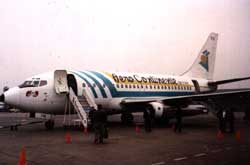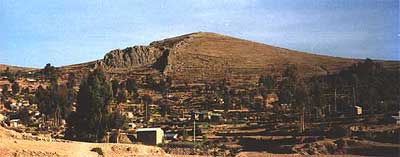
During our three days in the Lake Titcaca area we stayed two nights in Puno at
The Hotel Qelqatani. As their website notes,
we did have a memorable visit.
| Although the hotel lacked central heating (remember it is winter there when it is summer in the northern
hemisphere,) they did
provide an adequate space heater. It was nice because it was charming- the mural on their dinning
room wall is a work of folkart- and because it was only a couple of blocks
from Calle de Lima, Puno's main shopping area,
where we got some great bargains on alpaca sweaters.
We never did eat at a polleria, which is the Peruvian equivalent of
fast food; this owner has a sense of humor and marketing skills: |
 |
One of the highlights of
our stay was the visit to the floating reed islands of Uros.
| The people of Uros live on floating islands
made of reeds (tortura reeds) that grow in the lake. They began
to live on the reeds hundreds of years ago to try to stay away
from the Collas and the Incas who came to dominate the area.
The islands are made from layer upon layer of reeds. The reeds
do rot away from the bottom, but are replaced from the top.
It is unique to walk on one of these islands- the "ground"- it
is soft and springy. But there's no sense that you might fall
in! Surprisingly enough,
they have electricity on some of the larger of these islands!
From solar panels. |
 |

| The people make a living from selling crafts to tourists,
fishing, and raising pigs that they sell in the market in Puno.
The pigs live on floating islands too! |
 |
This textile depicts Pachamama and Pachatata (Mother Earth and Father Earth) and the founding of Uros.
The people settled on the reeds eons ago to avoid conflict with the local war-like Colla culture who were
conquered by the Incas.
|
| Traditionally, they used boats made of the reeds to get
around. The boats look like a canoe and most have a figurehead of a puma.
These
boats are famous since they served as the inspiration
and model for Thor Heyerdahl's Kon Tiki. This woman took us for a ride. |
 |
The second night we stayed with an Aymara family on the island of Amantani. It was great we got
to eat home cooked food
and climb to the top of the island (the real high point of our trip at almost 14,000 feet!)
 | People make a living growing potatoes, corn, beans, chickens, sheep and by hosting tourists.
Every family on the island that wants to takes turns hosting tourists; that way everybody
gets some needed cash. |
|
| Although the altitude was something of a problem
(you just have to go slow and take it easy and breath deeply),
we enjoyed our stay. Here we have lunch; our hostess was a great cook: |
 |
 |
On the way up the mountain, we got this picture of people harvesting potatoes. The Tiahuanaco
ruins at the top pay tribute to Pachamama and Pachatata (Mother Earth and Father Earth.)
Our guide Antonio, said that
local people still pay homage to these spirits. |
Our last day in the area, we visited the Cholla culture Chulpas, funeral towers, at Sillustani.

| We flew from Juliaca to Lima via Arequipa. At the airport in Juliaca,
we encountered another group of musicians playing for the tourists
and selling CDs. We bought another CD. |
 |
| Most of the internal flights were on one of Peru's three domestic
airlines- AeroContinente; the flight from Juliaca to Lima was eventful.
First when Antonio was helping us check in, the airline said they would
take passengers but no bags! He had his tour company office call and
persuade them to take us and our luggage. It runs out that this flight
was a small plane and it had to go with a stop over in Arequipa. The
runway in Areguipa is short and the company wasn't sure if the
little plane could take off- planes need more runway at high
altitude due to the lack of oxygen. When it stopped in Arequipa,
it flew over the El Misti volcano, barely. Then airport security
came on the plane and took everybody's carry on bags off and then returned them
after about 15 min. We figured out that they had weighed the carry on to make
sure the plane could take off OK. Then a few days later in Lima we read in the paper
(in Spanish, I remember enough to get by) that executives at the company had been
indicted for money laundering and the country of Chile had seized five planes!
|  |
 Top
of Page
Top
of Page














